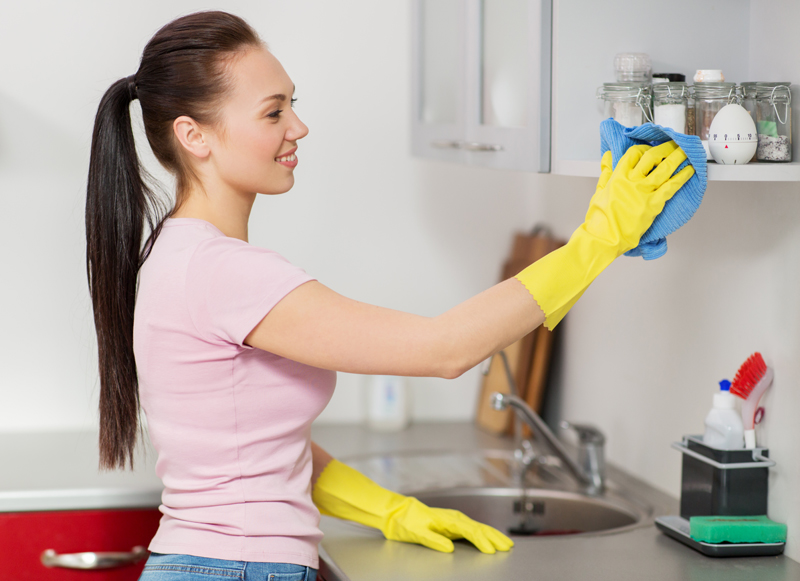
Thanks to the close proximity to the stovetop, kitchen cabinets are hotspots for sticky and unsightly grease stains.
That yellowing or darkening grime that plagues many a kitchen cabinet does not happen overnight, and the older the grease stains are, the stickier and more stubborn they become to remove. Getting them clean can be frustrating if you attempt to clean them without the proper supplies.
Ideally, you should be cleaning your cabinet fronts at least every other week using a damp cloth followed by a dry one; however, in some instances, we have to deal with a layer that’s too tough to remove with a simple wipe-down.
Dish soap is an alkaline-based product that effectively cuts through grease, especially when mixed in hot water.
Use grease-cutting dish soap into a bucket of very hot water because hot water helps to break down or melt through built-up grease. Get the water as hot as you can handle while wearing rubber gloves.
Squirt a tablespoon or two of dish soap into the water, and use a sponge with an attached nylon-scouring pad as your grease-killing weapon. Keep the water hot, and apply light pressure on the nylon pad in a circular motion to remove the stains without scratching the surface. Change the water as it cools. Rinse and dry your cabinetry with a soft cloth to a shine.
Vinegar is the go-to natural cleaner when faced with how to clean greasy cabinets. You can mix a 50/50 solution of vinegar and warm water and put into a spray bottle. Mist on cabinets, let sit for a minute or two.
Rinse your cloth with warm water, wring out most of the moisture, and use it to rinse the cabinetry and then wipe clean with a soft cloth. You can also add a few drops of liquid dishwashing detergent to the vinegar and water solution to clean extremely grimy cabinets.
For particularly stubborn stains, like syrup or chocolate, make a paste of vinegar and salt. Dip a toothbrush into the paste and lightly scrub in a circular motion to remove the stained area. Rinse and wipe clean.
You can bust through hardened, dingy layers of old, sticky, dust-grabbing grease using coconut oil and baking soda. Simply mix 1 part coconut oil with two parts baking soda in a small bowl. Apply the mixture to your cabinets with a cloth or sponge. It’s easy to work it into all the nooks and crannies using your gloved hands. For the grooves that are harder to reach with your fingers, use an old toothbrush. Rub the area with a non-scratching pad in a circular motion. Rinse with clean water and dry with a soft cloth.
Vegetable oil is oil that can soften and lift stubborn stains. Mix the oil with 2-parts baking soda for improved cleaning qualities. Rub in the baking-soda-and-oil paste with a soft cloth on the cabinets. You can use the paste to shine up grimy hinges, handles and pulls as well. Wash the cabinets with warm water and a little dish soap before rinsing and drying them.
After rigorous cleaning, wood cabinets are thirsty for moisture and protection, but be careful not to make matters worse by using something that will create a new kind of build-up. Look for products that contain beeswax, carnauba wax and orange oil to keep the wood from drying out while at the same time repelling kitchen grease.
Cleaning your kitchen cabinets of grease and grime doesn’t have to be a major chore if you do it regularly. A monthly routine will keep your cabinets looking great. Clean cabinets enhance the look of your kitchen and make it a more enjoyable place to work. There are also cleaning products that can also ruin wood on the market, so be sure to read and follow instructions before using them.
*Oakville / Burlington Ontario

